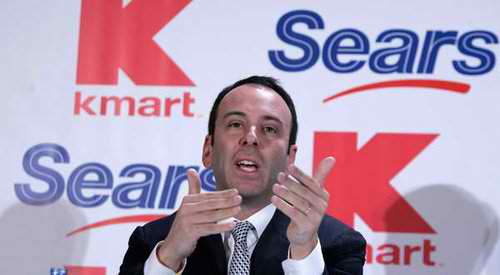Q. What do real estate and finance have in common?
A. Richard Baker and Eddie Lampert.
Q. What do Richard Baker and Eddie Lampert have in common?
A. Both designated themselves retail CEO’s.
Q. What do the success factors in real estate and finance have in common with retailing?
A. Nothing
Q. What retail experience did Richard Baker and Eddie Lampert have before taking over and running multi-billion dollar retail businesses?
A. None
It should be noted however, that there are two things Richard and Eddie do not have in common. First, Eddie’s business model for Sears Holdings (Sears and Kmart) is totally different from the retail model that Richard is putting together. Second, it took Eddie almost a decade of relentless decline and churning through a number of CEO’s to finally publically declare himself as the Chief. Richard Baker has taken the title of the new HBC conglomerate out of the starting gate.
Regardless, the most significant commonality, and a most important perspective to point out, is that these two brilliant professionals, having achieved enormous success at very young ages in their respective fields of real estate and finance, decided they could run multi-billion dollar retail businesses, a profession neither have one ounce of experience in. By the way, it’s also important to understand that even though Eddie became CEO just recently, make no mistake that he was acting CEO and micro-managing the business from the beginning.
And need I even say what we all know. Being a CEO is not “on the job training.”
So here’s the big question. Just as Eddie Lampert discovered he could not successfully run a retail business, and reverted to his financial brilliance to methodically manage Sears Holdings through its decline (and I predict eventual liquidation), does a similar fate await CEO Richard Baker? Will he discover he can’t successfully run three differently positioned and complex retail businesses and then revert back to his real estate brilliance to monetize the assets and sell them off? By the way, his original interest in Lord and Taylor and even Saks Inc. at the time, was all about the real estate. But it didn’t take long for the dazzle of retailing’s cash flow to inspire Mr. Baker’s move to become a retail mogul.
A final point on the CEO issue is that even though Mr. Baker has no retail experience (and particularly of this magnitude), he claims to have a team in place with significant retail experience across the various operating functions. Well that may be true, but in my opinion, each of these multi-billion dollar retail entities, and distinctly differentiated brands, require the expertise, vision and leadership that only a seasoned CEO can provide.
And finding great CEO’s who are willing to report to another CEO with less experience would seem to be a near impossibility. Two CEO’s departed L&T under Mr. Baker, both to find other substantive CEO positions at Children’s Place and Bon Ton. And what happens to the current CEO and team at Saks Inc. once the deal is done? It’s still up in the air.
The final potential commonality is the management style of both Lampert and Baker. We know what Eddie’s style is: micro-manage the business to the point at which no really great retail executives would even entertain working for him. Lampert’s “swinging door” style just keeps accelerating. We have yet to witness Mr. Baker’s style, although hints of it may have surfaced through the departures of the two L&T CEOs. However, only time will reveal his true form as he starts to implement the strategies and synergies he has been declaring.
The Logic Flow
From a purely business perspective, the consolidation of mature businesses, such as Hudson Bay, Saks Inc. and L&T, in relatively mature and (obnoxiously) over-saturated industries (not as bad in Canada), can provide short-term synergies such as cost-cutting opportunities; “unlocking” asset values (such as CEO Richard Baker’s suggested REIT strategy); gaining economies of scale; and more. It’s been estimated that there is between $100 and $300 million worth of such synergies to be had over the next few years.
Certainly Eddie Lampert recognized similar, albeit larger financial potential in 2004 when he placed two gargantuan-sized losers (Kmart and Sears) under the Sears Holdings Inc. umbrella. Declaring synergies, unlocking value, and boasting about the real estate value, Eddie went on to pronounce his commitment to return the two dying brands to their once-formidable spots in the world of retailing. Not only did it not happen, they continued to die, now at an accelerating pace as they near their end. However, Eddie has been brilliant in managing them into liquidation. And when the end comes, his lifeboat, weighed down with cash, will escape the undertow.
Now I’m not suggesting that any of the three retail brands acquired by Richard Baker are dying. However, “muddling along” in a slow-to-no-growth, over-stored (and web-sited), price deflating, and horrifically competitive industry, would be an apt description of their performance. With same-store sales in 2012 of 2.2% for L&T and Saks at 3.2%, compared to Nordstrom and Neiman Marcus with 7% and 6% respectively, I would say “muddling” is a fair assessment. Hudson Bay with 5.4% same-store sales is also nothing to write home about.
While “Fast Buck” Eddie unlocked value (monetizing assets like Sears’ brands for example) that could be sold off or sold wholesale to other retailers, he kind of locked down on capital expenditures, particularly for store maintenance, renovations and generally elevating the look and energy of the stores. In this regard, there is apparently no commonality between Richard and Eddie, as evidenced by Richard’s multi-million dollar revamp of the Hudson Bay and L&T stores, and what he has publicly stated to do in the Saks stores.
Having said that, retrofitting stores is no panacea.
Where’s The Beef?
So beyond the short-term tactics to cut costs and spiff up stores, what’s the vision; the competitive and consumer positioning; the long-term strategy for growth? Richard did have some strategic ideas in his presentation deck when announcing the acquisition of Saks Inc. However narrow these strategies may be, they are well beyond anything coming out of “Fast Buck” Eddie’s playbook for Sears Holdings. For almost a decade, has simply thrown one tactic after another against the wall to see which would stick.
We did read that Mr. Baker believes there is potential for seven full-line Saks stores and 25 Off Fifth outlet stores in Canada, or the possibility of Saks “shops” within Hudson Bay stores. Baker was quoted: \”We have this tremendous opportunity in Canada to roll out Saks. Department stores still make a lot of money.\” Canada is not as over-stored as the US, therefore, discounting is less aggressive. However, I also understand that Canada is not exploding with luxury demand and has always been more about frugality and “less is more” as a culture.
I guess that’s why Nordstrom, and eventually its Rack, is invading Canada like Attila the Hun. Advice to Richard: Nordstrom is the most profitable and fastest-growing luxury department store in the sector — for many reasons. I would advise Mr. Baker to heavily acknowledge Nordstrom in his SWOT analysis (particularly under the “threats” column), if indeed, he conducts such an analysis.
CEO Blake Nordstrom was quoted in an article regarding their launch into Canada: “…we don’t get too consumed with any competitors. In this specific case, I don’t think it really changes the landscape. We have a broader offering, We compete with Hudson’s Bay on one end, and we compete with Holts and now, presumably, Saks at the upper end, which is no different than what we have here in the US. If we can deliver the best Nordstrom experience up there, I think we’ll be successful regardless of what goes on outside our control.”
Also, I read that L&T might be a good replacement for some of the underperforming Saks stores in the US. It’s my understanding that a large number of the 41 full-line Saks stores at least border on being underperforming. Perhaps that’s why there are some 67 Saks Off Fifth outlet stores, and why they are the main growth driver in this hysterical discounting, price/value deflating quagmire of a retail market.
I hope Richard fully understands the US market. The only growth is coming from stealing customers away from competitors or getting current customers to buy more and/or more often. And the weapon of choice for survival is discounting, however it’s done, even in the luxury sector. If he understands that, why would L&T experience any more growth than the current Saks stores? Maybe a better strategy might be to replace them with outlet stores.
Furthermore, to this point, and of even greater strategic importance (if not the most important), is the unanswered question in everything I read: how does he intend to position these three brands among consumers? If that positioning is not done, and done well, in my opinion, it’s curtains regardless of who is running the show. Since Richard is going to be running all three brands, there is enormous danger of “blurring” the important differentiation among the brands, and particularly (without beating a dead horse), when Richard has had no experience in brand positioning in the first place.
Retail or Real Estate
Declare Yourself and Beware the REIT Trap
Just like Eddie, Richard is publicly declaring grand ideas for these iconic retail brands. The business is retailing, and Mr. Baker is eager to position the three brands for robust growth. Eddie tried for about six years or so, while his top and bottom lines dropped quarter after quarter, year after year. He then reverted to what he does best. “Fast Buck” Eddie Lampert is his name, finance is his game. And, he is always brilliantly employing this genius.
Does a similar fate await Richard Baker? Is real estate his real “game?”
When I hear a strong suggestion from Mr. Baker that forming a REIT is a great idea, I say whoa! Why is stealing from Peter to pay Paul a good idea? Pulling the real estate asset out from under the retailer and putting it into a trust, which then turns around and leases the space to the retailer, is what finally killed Mervyn’s when Cerberus (who owned them) made the REIT move several years ago.
So Mr. Baker, if you are CEO of a three-retail-brand operation, and that is your true business, why would you take any risk in devaluing those brands? Oh well, maybe you are running two businesses: retail and real estate, just as Eddie is running two businesses: retail and finance. The writing is on the wall, we have seen where Lampert’s retail business is going – and fast.
How about management style? Eddie went through more CEO’s, C- and senior-level executives than Heinz has pickles — many of them true and capable retail veterans. Yet Eddie thought he was somehow smarter than any of them; he just couldn’t “unlock their value,” so to speak. In reality, Eddie was CEO over everything all the time, even when he gave the title to those he kept firing.
Is this a commonality Richard shares with Eddie?
I hope not. What this industry doesn’t need is another financial vulture who unlocks value and turns it into cash for lining his lifeboat; nor does it need a comparable predator posing as real estate mogul. It needs real visionaries who pursue real innovations that provide consumers with real added value.
I hope Richard Baker is a true visionary and allows experienced retail executives who understand the competitive and consumer marketplace full authority to run each of the three distinctly different brands and businesses he is about to own.
This jury of one, moi, has not yet seen or heard enough to deliver a verdict.




